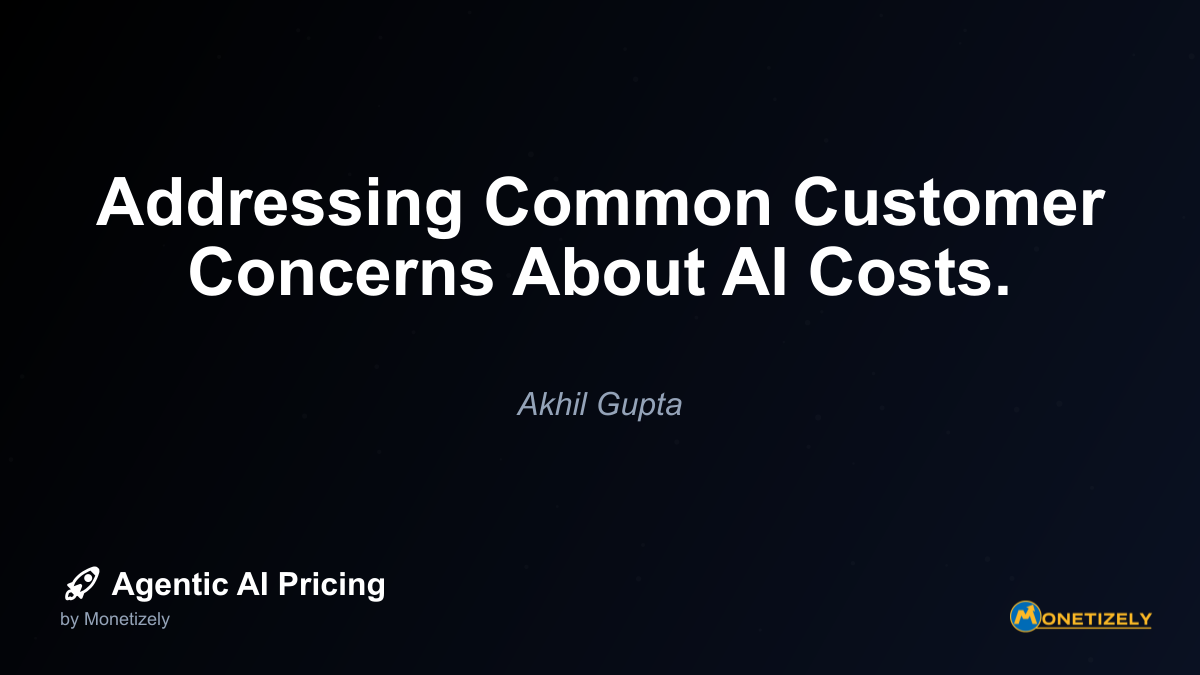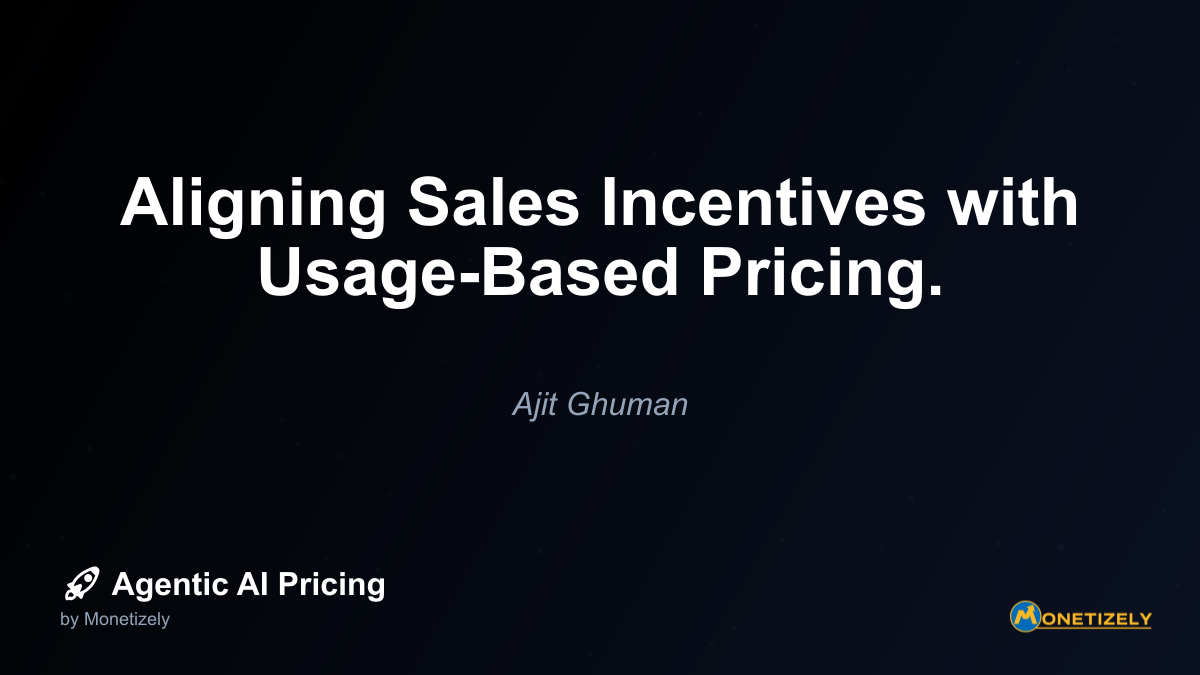· Ajit Ghuman · Best Practices · 10 min read
Preventing Sticker Shock: Avoiding Unexpected AI Bills.
AI and SaaS Pricing Masterclass
Learn the art of strategic pricing directly from industry experts. Our comprehensive course provides frameworks and methodologies for optimizing your pricing strategy in the evolving AI landscape. Earn a professional certification that can be imported directly to your LinkedIn profile.

In today’s rapidly evolving AI landscape, businesses eager to leverage intelligent technologies face a common yet troubling challenge: unexpected costs. As organizations integrate AI solutions into their operations, many encounter the jarring experience of “sticker shock” when the bill arrives. This phenomenon isn’t merely an inconvenience—it represents a significant barrier to AI adoption and can damage the vendor-customer relationship before it has a chance to flourish.
The issue stems from the unique consumption-based pricing models that dominate AI services. Unlike traditional software with predictable subscription fees, AI usage can fluctuate dramatically based on numerous factors, from query volume to processing complexity. When customers lack visibility into how these factors translate to costs, the stage is set for billing surprises that can derail budgets and erode trust.
Both AI vendors and their customers share responsibility in preventing these unwelcome surprises. Through thoughtful pricing design, transparent communication, and proactive management tools, the industry can foster an environment where AI costs remain predictable, manageable, and aligned with business value.
This article explores practical strategies to prevent AI billing surprises from both the vendor and customer perspective, ensuring that innovative AI solutions deliver their promised value without the unwelcome aftershock of unexpected expenses.
Understanding the Root Causes of AI Billing Surprises
Before addressing solutions, it’s essential to understand why AI services are particularly susceptible to unexpected costs. Several factors contribute to this challenge:
Consumption-Based Pricing Complexity
Most AI services employ consumption-based pricing models where costs scale with usage. This approach makes sense in theory—customers pay for what they use—but the complexity lies in how “usage” is defined and measured. Depending on the service, billing might be based on:
- Number of API calls or queries
- Tokens processed (input and output)
- Computational resources consumed (GPU/CPU hours)
- Data storage requirements
- Model training time
- Fine-tuning operations
The interplay between these factors creates a multidimensional cost structure that can be difficult for customers to project accurately, especially when their usage patterns are still emerging.
Unpredictable Usage Patterns
During initial adoption, organizations often lack historical data to forecast their AI consumption accurately. Usage can spike unexpectedly due to:
- Seasonal business fluctuations
- Viral product features driving unexpected adoption
- Integration with other systems that generate automated requests
- Debugging or testing activities consuming real resources
- Inefficient prompt engineering leading to unnecessary token usage
Without mechanisms to monitor and control these patterns, costs can quickly exceed expectations.
Misalignment Between Technical and Financial Planning
In many organizations, the teams implementing AI solutions (typically engineering or product) operate separately from those managing budgets (finance or procurement). This separation can lead to disconnects where:
- Technical teams optimize for performance or user experience without full awareness of cost implications
- Financial teams allocate budgets based on incomplete understanding of how AI consumption scales
- Approval processes fail to account for the variable nature of AI expenditures
The Hidden Costs of “Free” Trials
Many AI vendors offer generous free tiers or trial periods to encourage adoption. While beneficial for initial experimentation, these can create false expectations about ongoing costs. When usage exceeds free allowances or trials expire, the transition to paid tiers can come as a shock if not properly anticipated and communicated.
Vendor Strategies to Prevent Customer Sticker Shock
AI service providers play a crucial role in preventing billing surprises. The following strategies not only protect customers but also build trust and reduce churn—a win-win for the ecosystem.
Transparent Pricing Communication
Clear, Accessible Pricing Documentation
Pricing information should be comprehensive yet digestible. Effective practices include:
- Providing concrete examples that illustrate how different usage patterns translate to costs
- Using plain language that non-technical stakeholders can understand
- Maintaining up-to-date documentation that reflects all current pricing tiers and options
- Highlighting common cost drivers and potential pitfalls specific to the service
Interactive Cost Calculators
Cost calculators allow customers to model different usage scenarios and understand potential expenses before committing. Effective calculators:
- Accept inputs that correspond to real-world usage patterns (e.g., daily active users, average queries per user)
- Show how costs scale across different tiers or volume breakpoints
- Allow comparison between different service levels or configurations
- Provide exportable results for budget planning purposes
Proactive Monitoring and Alerting Tools
Usage Dashboards with Near Real-Time Updates
Customers need visibility into their consumption as it occurs, not just when the bill arrives. Comprehensive dashboards should:
- Display current usage across all relevant metrics
- Show trending information to highlight changing patterns
- Provide breakdowns by team, project, or application when applicable
- Offer exportable data for internal reporting and analysis
Customizable Alert Thresholds
Allowing customers to set their own alert thresholds ensures they receive timely notifications when usage approaches significant levels:
- Percentage-based alerts (e.g., 50%, 75%, 90% of expected monthly usage)
- Absolute value thresholds for critical cost boundaries
- Anomaly detection to flag unusual spikes or patterns
- Multiple notification channels (email, SMS, in-platform alerts) with appropriate urgency
Flexible Billing Controls
Usage Caps and Rate Limiting
Giving customers control over maximum expenditure provides essential guardrails:
- Hard caps that automatically pause service when thresholds are reached
- Soft caps that trigger alerts but allow continued service
- Granular caps at the API endpoint, model, or feature level
- Rate limiting options to prevent unintended high-volume usage
Budget Management Features
More sophisticated budget tools help customers align AI expenses with their financial planning:
- Monthly or quarterly budget allocation with automatic adjustments
- Roll-over options for unused capacity
- Reserved capacity purchasing for predictable baseline usage
- Internal chargeback mechanisms for multi-department organizations
Thoughtful Pricing Model Design
Predictable Pricing Tiers
While consumption-based pricing offers flexibility, incorporating elements of predictability helps customers budget effectively:
- Offering hybrid models with base subscription plus overage charges
- Providing volume discounts that reduce per-unit costs as usage scales
- Creating specialized plans for different usage profiles (e.g., development vs. production)
- Implementing “burst” pricing that accommodates occasional spikes without permanent tier increases
Grace Periods and Forgiveness Policies
Customer-friendly policies around unexpected usage help build goodwill:
- First-time overage forgiveness programs
- Retroactive application of volume discounts when thresholds are unexpectedly reached
- Cooling-off periods before enforcing tier upgrades due to usage spikes
- Proactive outreach when unusual patterns are detected before billing occurs
Customer Strategies to Prevent AI Billing Surprises
While vendors bear significant responsibility, customers must also take proactive steps to manage their AI expenses effectively.
Comprehensive Pre-Adoption Planning
Usage Pattern Analysis
Before fully committing to an AI service, organizations should conduct thorough analysis:
- Audit existing processes to identify how and where AI will be integrated
- Estimate transaction volumes under various business scenarios
- Consider seasonal fluctuations and growth projections
- Benchmark against similar organizations when possible
Pilot Programs with Controlled Exposure
Starting small allows for cost pattern discovery without major financial risk:
- Limit initial deployment to specific teams or use cases
- Establish clear success metrics that include cost-effectiveness
- Gradually expand based on validated usage patterns
- Document learnings about cost drivers for future planning
Implementation of Internal Governance
Clear Ownership and Accountability
Designating specific responsibility for AI cost management ensures it doesn’t fall through organizational cracks:
- Appointing AI expense owners within each department
- Creating cross-functional teams that include both technical and financial stakeholders
- Establishing regular review cadences for AI expenditures
- Developing escalation paths for addressing unexpected cost increases
Usage Policies and Guidelines
Documented guidelines help prevent inadvertent cost escalation:
- Defining approved use cases and permissible usage patterns
- Establishing protocols for testing and development activities
- Creating approval workflows for high-volume or expensive operations
- Implementing technical guardrails that enforce policy compliance
Technical Optimization Strategies
Efficient Prompt Engineering
For generative AI services, prompt design significantly impacts costs:
- Crafting concise prompts that minimize token usage
- Implementing client-side validation to prevent unnecessary requests
- Using appropriate model sizes for different tasks (not defaulting to the largest)
- Caching common responses to reduce redundant queries
Architectural Considerations
System design choices can dramatically affect AI service consumption:
- Implementing appropriate caching strategies at multiple levels
- Batching requests when possible to reduce API call overhead
- Preprocessing inputs to minimize the data sent to AI services
- Creating fallback mechanisms that use simpler, less expensive approaches for routine cases
Ongoing Monitoring and Optimization
Regular Usage Audits
Systematic review of AI consumption helps identify optimization opportunities:
- Analyzing usage patterns across teams and applications
- Identifying outliers or anomalies that warrant investigation
- Comparing actual usage against projected estimates
- Documenting the business value derived from different AI interactions
Continuous Improvement Process
Treating AI cost management as an ongoing discipline rather than a one-time exercise:
- Establishing KPIs that balance cost and performance metrics
- Creating feedback loops between financial outcomes and technical decisions
- Sharing best practices across teams and projects
- Staying informed about vendor pricing changes and new optimization opportunities
Collaborative Approaches for Vendor-Customer Alignment
The most effective strategies for preventing AI billing surprises involve collaboration between vendors and customers.
Structured Onboarding Processes
Joint Usage Forecasting
Working together to establish realistic expectations:
- Vendor sharing typical usage patterns from similar customers
- Customer providing business context and growth projections
- Collaborative modeling of different adoption scenarios
- Documentation of assumptions for future reference and adjustment
Gradual Implementation Roadmaps
Planning staged rollouts that allow for cost learning and adjustment:
- Starting with limited scope and controlled user groups
- Establishing checkpoints for reviewing usage and costs
- Adjusting implementation plans based on emerging patterns
- Scaling gradually with appropriate monitoring and controls
Ongoing Communication Channels
Regular Business Reviews
Scheduled sessions focused specifically on usage, value, and cost alignment:
- Reviewing actual consumption against projections
- Identifying optimization opportunities from both perspectives
- Discussing upcoming features or changes that might impact usage
- Adjusting plans and forecasts based on evolving business needs
Dedicated Success Management
Assigning specific vendor personnel to help navigate cost considerations:
- Providing proactive alerts about unusual usage patterns
- Offering guidance on optimization best practices
- Serving as advocates when billing questions arise
- Facilitating connections with technical resources when needed
Flexible Commercial Arrangements
Ramp-Up Pricing
Special terms that accommodate the uncertainty of initial adoption:
- Discounted rates during initial implementation periods
- Gradual transition to standard pricing as usage patterns stabilize
- Credits for proof-of-concept or pilot phases
- Consumption commitments that increase over time rather than immediately
True-Ups and Reconciliation Processes
Mechanisms to address misalignment between expected and actual usage:
- Quarterly reconciliation against committed spending levels
- Retroactive tier adjustments based on actual consumption patterns
- Credit banking for future use when overages occur
- Annual renewal processes that incorporate historical usage data
Industry-Specific Considerations
Different sectors face unique challenges in managing AI costs effectively.
Enterprise Organizations
Large organizations typically have complex governance structures that require:
- Multi-level approval processes for AI expenditures
- Integration with enterprise procurement systems
- Departmental chargeback mechanisms
- Compliance with corporate spending policies
Startups and Growth Companies
Emerging companies often face different constraints:
- Limited cash flow requiring strict budget adherence
- Rapidly changing usage patterns as products evolve
- Tension between innovation speed and cost control
- Need for flexible scaling as customer adoption grows
Public Sector and Non-Profits
Organizations with fixed funding cycles or grant-based budgets require:
- Predictable long-term cost projections
- Alignment with fiscal year planning
- Documentation for stakeholder or donor accountability
- Value measurement beyond commercial metrics
Conclusion: Building a Sustainable AI Ecosystem
Preventing AI billing surprises isn’t merely about avoiding customer dissatisfaction—it’s fundamental to building a sustainable AI ecosystem where both vendors and customers can thrive. When organizations can confidently predict and manage their AI expenses, they’re more likely to:
- Expand their usage to new use cases and departments
- Invest in deeper integration and customization
- Advocate for AI adoption within their industry
- Develop long-term partnerships with their providers
The strategies outlined in this article represent best practices that benefit the entire AI marketplace. By implementing transparent pricing, proactive monitoring, flexible controls, and collaborative planning, the industry can remove a significant barrier to AI adoption and ensure that conversations focus on value creation rather than billing disputes.
As AI continues to evolve, so too will the approaches to pricing and cost management. Vendors who lead in creating transparent, customer-friendly billing experiences will gain competitive advantage through higher retention and positive word-of-mouth. Simultaneously, customers who develop sophisticated AI governance and optimization practices will extract greater value from their investments while maintaining predictable expenses.
The most successful AI implementations will be those where cost management is integrated from the beginning—not as an afterthought or reaction to unexpected bills. By addressing the potential for sticker shock proactively, both providers and users of AI services can focus on what matters most: harnessing these powerful technologies to drive innovation and create meaningful business impact.
Co-Founder & CEO
Ajit is the author of Price To Scale, a top book on SaaS Pricing and is the Founder of Monetizely. Ajit has led and worked in pricing and product marketing at firms like Twilio, Narvar and Medallia. His work has been featured in Forbes and VentureBeat. Ajit regularly consults with software companies from Seed stage to post-IPO on pricing strategy. Ajit is also a highly-rated co-instructor for 'The Art of SaaS Pricing and Monetization' on Maven.
Pricing Strategy Audit
Let our experts analyze your current pricing strategy and identify opportunities for improvement. Our data-driven assessment will help you unlock untapped revenue potential and optimize your AI pricing approach.




